Mantle-Derived Corundum-Bearing Felsic Dykes May Survive Only within the Lower (Refractory/Inert) Crust: Evidence from Zircon Geochemistry and Geochronology (Ivrea–Verbano Zone, Southern Alps, Italy)
Abstract
:1. Introduction
2. Materials and Methods
2.1. LA-ICP-MS U–Pb Dating and Trace Element Composition
2.2. Zircon Hf Isotopes
2.3. Thermodynamic Modelling
3. Geological Setting and Geochronological Background
4. Results
4.1. Field Evidence, Petrography and Mineral Chemistry
4.2. Zircon Internal Features
4.3. Zircon Isotopic and Chemical Data
4.4. Thermodynamic Modelling of Corundum-Bearing Felsic Dykes
5. Discussion
5.1. Field and Textural Constraints on Magmatic Process
5.2. Timing and P-T Estimates for Felsic Dykes Intrusion
5.3. A Possible Genetic Model of Corundum-Saturated Felsic Melts
5.4. Survival of Corundum-Bearing Felsic Dykes: The Role of the Refractory Lower Crustal Rocks
5.5. Geodynamic Implications
6. Conclusions
Supplementary Materials
Author Contributions
Funding
Acknowledgments
Conflicts of Interest
References
- Tumiati, S.; Zanchetta, S.; Pellegrino, L.; Ferrario, C.; Casartelli, S.; Malaspina, N. Granulite-facies Overprint in Garnet Peridotites and Kyanite Eclogites of Monte Duria (Central Alps, Italy): Clues from Srilankite-and Sapphirine-Bearing Symplectites. J. Pet. 2018, 59, 115–151. [Google Scholar] [CrossRef]
- Simonet, C.; Fritsch, E.; Lasnier, B. A classification of gem corundum deposits aimed towards gem exploration. Ore Geol. Rev. 2008, 34, 127–133. [Google Scholar] [CrossRef]
- Giuliani, G.; Groat, L.A.; Fallick, A.E.; Pignatelli, I.; Pardieu, V. Ruby Deposits: A Review and Geological Classification. Minerals 2020, 10, 597. [Google Scholar] [CrossRef]
- Liu, T.-C.; Presnall, D.C. Liquidus phase relationships on the join anorthiteforsterite-quartz at 20 kbar with applications to basalt petrogenesis and igneous sapphirine. Contrib. Miner. Pet. 1990, 104, 735–742. [Google Scholar] [CrossRef]
- Sen, G.; Presnall, D.C. Liquidus phase relationships on the join anorthite-forsterite-quartz at 10 kbar with applications to basalt petrogenesis. Contrib. Miner. Pet. 1984, 85, 404–408. [Google Scholar] [CrossRef]
- Lawson, A.C. Plumasite, an Oligoclase-Corundum Rock near Spanish Peak; University of California Press: California, CA, USA, 1903. [Google Scholar]
- Du Toit, A. Plumasite (corundum-aplite) and titaniferous magnetite rocks from Natal. S. Afr. J. Geol. 1918, 21, 53–73. [Google Scholar]
- Gordon, S.G. Desilicated granitic pegmatites. P. Acad. Nat. Sci. Phila. 1921, 73, 169–192. [Google Scholar]
- Troshin, Y.P. The fluid regime in the formation of rare-metal plumasite granites in Eastern Transbaikalia. Sov. Geol. Geophys. 1983, 24, 59–67. [Google Scholar]
- Peucat, J.; Ruffault, P.; Fritsch, E.; Coz, M.B.-L.; Simonet, C.; Lasnier, B. Ga/Mg ratio as a new geochemical tool to differentiate magmatic from metamorphic blue sapphires. Lithos 2007, 98, 261–274. [Google Scholar] [CrossRef]
- Voudouris, P.; Mavrogonatos, C.; Graham, I.T.; Giuliani, G.; Melfos, V.; Karampelas, S.; Karantoni, V.; Wang, K.; Tarantola, A.; Zaw, K.; et al. Gem Corundum Deposits of Greece: Geology, Mineralogy and Genesis. Minerals 2019, 9, 49. [Google Scholar] [CrossRef] [Green Version]
- Larsen, E.S. A hydrothermal origin of corundum and albitite bodies. Econ. Geol. 1928, 23, 398–433. [Google Scholar] [CrossRef]
- Bertolani, M. La posizione petrogenetica di alcuni filoni corindoniferi della Val Sabbiola (Valsesia). Rend. Soc. Geol. It. 1957, 13, 120–130. [Google Scholar]
- Langone, A.; Padrón-Navarta, J.A.; Ji, W.-Q.; Zanetti, A.; Mazzucchelli, M.; Tiepolo, M.; Giovanardi, T.; Bonazzi, M.; Antonio, L.; Alberto, P.-N.J.; et al. Ductile–brittle deformation effects on crystal-chemistry and U–Pb ages of magmatic and metasomatic zircons from a dyke of the Finero Mafic Complex (Ivrea–Verbano Zone, Italian Alps). Lithos 2017, 284, 493–511. [Google Scholar] [CrossRef]
- Giuliani, G.; Fallick, A.E.; Ohnenstetter, D.; Pegere, G. Oxygen isotopes composition of sapphires from the French Massif Central: Implications for the origin of gem corundum in basaltic fields. Miner. Deposita 2008, 44, 221–231. [Google Scholar] [CrossRef]
- Lelièvre. Mémoire sur un gisement de corindon. J. Phys. Chim. Hist. Nat. 1812, 74-75, 463–466. [Google Scholar]
- Cossa, A. Sul feldspato corindonifero del biellese. Atti R. Accad. Lincei 1879, 3, 229. [Google Scholar]
- Millosevich, F. Le rocce a corindone dell Val Sessera (Prealpi Biellesi). Atti R. Accad. Lincei 1927, 5, 6–22. [Google Scholar]
- Rossi, A. Le rocce corindonifere del “Croso della Gavala” (Valsesia-Vercelli). Schweiz. Miner. Petrog. 1968, 48, 67–74. [Google Scholar]
- Stähle, V.; Frenzel, G.; Kober, B.; Michard, A.; Puchelt, H.; Schneider, W. Zircon syenite pegmatites in the Finero peridotite (Ivrea zone): Evidence for a syenite from a mantle source. Earth Planet. Sci. Lett. 1990, 101, 196–205. [Google Scholar] [CrossRef]
- Stähle, V.; Frenzel, G.; Hess, J.C.; Saupe, F.; Schmidt, S.T.; Schneider, W. Permian metabasalt and Triassic alkaline dykes in the northern Ivrea: Clues to the post-Variscan geodynamic evolution of the Southern Alps. Schweiz. Miner. Petrog. 2001, 81, 1–21. [Google Scholar]
- Schaltegger, U.; Ulianov, A.; Muntener, O.; Ovtcharova, M.; Peytcheva, I.; Vonlanthen, P.; Vennemann, T.; Antognini, M.; Girlanda, F. Megacrystic zircon with planar fractures in miaskite-type nepheline pegmatites formed at high pressures in the lower crust (Ivrea Zone, southern Alps, Switzerland). Am. Miner. 2014, 100, 83–94. [Google Scholar] [CrossRef]
- Zingg, A. The Ivrea and Strona-Ceneri zones (southern Alps, Ticino and N- Italy) - a review. Schweiz. Miner. Petrog. 1983, 63, 361–392. [Google Scholar]
- Sinigoi, S.; Quick, J.E.; Demarchi, G.; Peressini, G. The Sesia Magmatic System. J. Virtual Explor. 2010, 36, 1–33. [Google Scholar] [CrossRef]
- Whitney, D.L.; Evans, B.W. Abbreviations for names of rock-forming minerals. Am. Miner. 2009, 95, 185–187. [Google Scholar] [CrossRef]
- Harley, S.L.; Kelly, N. The impact of zircon–garnet REE distribution data on the interpretation of zircon U–Pb ages in complex high-grade terrains: An example from the Rauer Islands, East Antarctica. Chem. Geol. 2007, 241, 62–87. [Google Scholar] [CrossRef]
- Harley, S.L.; Kelly, N. Zircon Tiny but Timely. Elements 2007, 3, 13–18. [Google Scholar] [CrossRef]
- Tiepolo, M. In situ Pb geochronology of zircon with laser ablation–inductively coupled plasma–sector field mass spectrometry. Chem. Geol. 2003, 199, 159–177. [Google Scholar] [CrossRef]
- Jackson, J.M.; Sinogeikin, S.V.; Carpenter, M.A.; Bass, J.D. Novel phase transition in orthoenstatite. Am. Miner. 2004, 89, 239–244. [Google Scholar] [CrossRef]
- Wiedenbeck, M.; Allé, P.; Corfu, F.; Griffin, W.L.; Meier, M.; Oberli, F.; Von Quadt, A.; Roddick, J.; Spiegel, W. Three natural zircon standards for u-th-pb, lu-hf, trace element and ree analyses. Geostandard. Newslett. 1995, 19, 1–23. [Google Scholar] [CrossRef]
- Sláma, J.; Košler, J.; Condon, D.J.; Crowley, J.L.; Gerdes, A.; Hanchar, J.M.; Horstwood, M.S.A.; Morris, G.A.; Nasdala, L.; Norberg, N.; et al. Plešovice zircon — A new natural reference material for U–Pb and Hf isotopic microanalysis. Chem. Geol. 2008, 249, 1–35. [Google Scholar] [CrossRef]
- Van Achterbergh, E.; Ryan, C.; Griffin, W. GLITTER On-Line Interactive Data Reduction for the LA-ICPMS Microprobe; Macquarie Research Ltd.: Sydney, Australia, 2001. [Google Scholar]
- Horstwood, M.S.A.; Parrish, R.R.; Nowell, G.; Foster, G.L.; Noble, S. Common-Pb corrected in situ U–Pb accessory mineral geochronology by LA-MC-ICP-MS. J. Anal. At. Spectrom. 2003, 18, 837. [Google Scholar] [CrossRef]
- Ludwig, K.R. Isoplot 3.00: A Geochronological Toolkit for Microsoft Excel; Berkeley Geochronology Center Special Publication: Berkeley, CA, USA, 2003; Volume 4, p. 70. [Google Scholar]
- Giovanardi, T.; Mazzucchelli, M.; Lugli, F.; Girardi, V.A.; Correia, C.; Tassinari, C.C.; Cipriani, A. Isotopic constraints on contamination processes in the Tonian Goiás Stratiform Complex. Lithos 2018, 310, 136–152. [Google Scholar] [CrossRef]
- Giovanardi, T.; Lugli, F. The Hf-INATOR: A free data reduction spreadsheet for Lu/Hf isotope analysis. Earth Sci. Inform. 2017, 10, 517–523. [Google Scholar] [CrossRef]
- Matteini, M.; Dantas, E.L.; Pimentel, M.M.; Buhn, B. Combined U-Pb and Lu-Hf isotope analyses by laser ablation MC-ICP-MS: Methodology and applications. An. Acad. Bras. Ciênc. 2010, 82, 479–491. [Google Scholar] [CrossRef] [Green Version]
- Blichert-Toft, J.; Albarede, F. The Lu-Hf isotope geochemistry of chondrites and the evolution of the mantle-crust system. Earth Planet. Sci. Lett. 1997, 148, 243–258. [Google Scholar] [CrossRef]
- Connolly, J.A. Computation of phase equilibria by linear programming: A tool for geodynamic modeling and its application to subduction zone decarbonation. Earth Planet. Sci. Lett. 2005, 236, 524–541. [Google Scholar] [CrossRef]
- Holland, T.J.B.; Powell, R. An internally consistent thermodynamic data set for phases of petrological interest. J. Metamorph. Geol. 2004, 16, 309–343. [Google Scholar] [CrossRef]
- Schmid, S.M.; Raumer, J.F. Ivrea Zone and Adjacent Southern Alpine Basement. In Pre-Mesozoic Geology in the Alps; Springer Science and Business Media LLC: Berlin/Heidelberg, Germany, 1993; pp. 567–583. [Google Scholar] [CrossRef]
- Boriani, A.; Burlini, L.; Sacchi, R. The Cossato-Mergozzo-Brissago Line and the Pogallo Line (Southern Alps, Northern Italy) and their relationships with the late-Hercynian magmatic and metamorphic events. Tectonophysics 1990, 182, 91–102. [Google Scholar] [CrossRef]
- Boriani, A.C.; Villa, I.M. Geochronology of regional metamorphism in the Ivrea-Verbano Zone and Serie dei Laghi, Italian Alps. Schweiz. Miner. Petrog. 1997, 77, 381–401. [Google Scholar] [CrossRef]
- Mulch, A.; Rosenau, M.; Dörr, W.; Handy, M.R. The age and structure of dikes along the tectonic contact of the Ivrea-Verbano and Strona-Ceneri Zones (Southern Alps, Northern Italy, Switzerland). Schweiz. Miner. Petrog. 2002, 82, 55–76. [Google Scholar]
- Hodges, K.V.; Fountain, D.M. Pogallo Line, South Alps, northern Italy: An intermediate crystal level, low-angle normal fault? Geology 1984, 12, 151. [Google Scholar] [CrossRef]
- Zingg, A.; Handy, M.; Hunziker, J.; Schmid, S. Tectonometamorphic history of the Ivrea Zone and its relationship to the crustal evolution of the Southern Alps. Tectonophysics 1990, 182, 169–192. [Google Scholar] [CrossRef]
- Schmid, R.; Wood, B.J. Phase relationships in granulitic metapelites from the Ivrea-Verbano zone (Northern Italy). Contrib. Miner. Pet. 1976, 54, 255–279. [Google Scholar] [CrossRef]
- Henk, A.; Franz, L.; Teufel, S.; Oncken, O. Magmatic Underplating, Extension, and Crustal Reequilibration: Insights From A Cross-Section Through the Ivrea Zone and Strona-Ceneri Zone, Northern Italy. J. Geol. 1997, 105, 367–378. [Google Scholar] [CrossRef]
- Peressini, G.; Quick, J.E.; Sinigoi, S.; Hofmann, A.W.; Fanning, C.M. Duration of a Large Mafic Intrusion and Heat Transfer in the Lower Crust: A SHRIMP U-Pb Zircon Study in the Ivrea-Verbano Zone (Western Alps, Italy). J. Pet. 2007, 48, 1185–1218. [Google Scholar] [CrossRef] [Green Version]
- Rivalenti, G.; Garuti, G.; Rossi, A. The origin of the Ivrea-Verbano basic formation (western italian Alps) - whole rock geochemistry. Boll. Soc. Geol. Ital. 1975, 94, 1149–1186. [Google Scholar]
- Ewing, T.; Hermann, J.; Rubatto, D.; Hermann, J. The robustness of the Zr-in-rutile and Ti-in-zircon thermometers during high-temperature metamorphism (Ivrea-Verbano Zone, northern Italy). Contrib. Miner. Pet. 2012, 165, 757–779. [Google Scholar] [CrossRef]
- Kunz, B.E.; Manzotti, P.; Von Niederhäusern, B.; Engi, M.; Darling, J.R.; Giuntoli, F.; Lanari, P. Permian high-temperature metamorphism in the Western Alps (NW Italy). Acta Diabetol. 2017, 107, 203–229. [Google Scholar] [CrossRef] [Green Version]
- Klötzli, U.S.; Sinigoi, S.; Quick, J.E.; Demarchi, G.; Tassinari, C.C.; Sato, K.; Günes, Z. Duration of igneous activity in the Sesia Magmatic System and implications for high-temperature metamorphism in the Ivrea–Verbano deep crust. Lithos 2014, 206, 19–33. [Google Scholar] [CrossRef]
- Karakas, O.; Wotzlaw, J.-F.; Guillong, M.; Ulmer, P.; Brack, P.; Economos, R.; Bergantz, G.W.; Sinigoi, S.; Bachmann, O. The pace of crustal-scale magma accretion and differentiation beneath silicic caldera volcanoes. Geology 2019, 47, 719–723. [Google Scholar] [CrossRef] [Green Version]
- Garuti, G.; Bea, F.; Zaccarini, F.; Montero, P. Age, Geochemistry and Petrogenesis of the Ultramafic Pipes in the Ivrea Zone, NW Italy. J. Pet. 2001, 42, 433–457. [Google Scholar] [CrossRef]
- Locmelis, M.; Fiorentini, M.L.; Rushmer, T.; Arevalo, R.; Adam, J.; Denyszyn, S.W. Sulfur and metal fertilization of the lower continental crust. Lithos 2016, 244, 74–93. [Google Scholar] [CrossRef] [Green Version]
- Denyszyn, S.W.; Fiorentini, M.; Maas, R.; Dering, G. A bigger tent for CAMP. Geology 2018, 46, 823–826. [Google Scholar] [CrossRef] [Green Version]
- Fiorentini, M.; Laflamme, C.; Denyszyn, S.W.; Mole, D.; Maas, R.; Locmelis, M.; Caruso, S.; Bui, T.-H. Post-collisional alkaline magmatism as gateway for metal and sulfur enrichment of the continental lower crust. Geoch. Cosmochim. Ac. 2018, 223, 175–197. [Google Scholar] [CrossRef]
- Galli, A.; Grassi, D.; Sartori, G.; Gianola, O.; Burg, J.-P.; Schmidt, M. Jurassic carbonatite and alkaline magmatism in the Ivrea zone (European Alps) related to the breakup of Pangea. Geology 2019, 47, 199–202. [Google Scholar] [CrossRef] [Green Version]
- Zanetti, A.; Mazzucchelli, M.; Sinigoi, S.; Giovanardi, T.; Peressini, G.; Fanning, C.M. SHRIMP U-Pb Zircon Triassic Intrusion Age of the Finero Mafic Complex (Ivrea-Verbano Zone, Western Alps) and its Geodynamic Implications. J. Pet. 2013, 54, 2235–2265. [Google Scholar] [CrossRef] [Green Version]
- Von Quadt, A.; Ferrario, A.; Diella, V.; Hansmann, W.; Vavra, G.; Koeppel, V. U–Pb ages of zircons from chromitites of the phlogopite peridotite of Finero Ivrea zone, northern Italy. Schweiz. Miner. Petrog. 1993, 73, 137–138. [Google Scholar]
- Grieco, G.; Ferrario, A.; Von Quadt, A.; Koeppel, V.; Mathez, E.A. The Zircon-Bearing Chromitites of the Phlogopite Peridotite of Finero (Ivrea Zone, Southern Alps): Evidence and Geochronology of a Metasomatized Mantle Slab. J. Pet. 2001, 42, 89–101. [Google Scholar] [CrossRef] [Green Version]
- Hingerl, F.; Klötzli, U.; Steuber, C.; Kleinschrodt, R. New results from the mafic complex in the Finero area. In Proceedings of the 33th International Geological Congress, Oslo, Norway, 6–14 August 2008; pp. 6–14. [Google Scholar]
- Oppizzi, P.; Schaltegger, U. Zircon-bearing plagioclasites from the Finero complex (Ivrea zone): Dating a Late Triassic mantle hic-cup. Schweiz. Miner. Petrog. 1999, 79, 330–331. [Google Scholar]
- Hoek, J.D. A classification of dyke-fracture geometry with examples from Precambrian dyke swarms in the Vestfold Hills, Antarctica. Geol. Rundsch. 1991, 80, 233–248. [Google Scholar] [CrossRef]
- Vermeesch, P. IsoplotR: A free and open toolbox for geochronology. Geosci. Front. 2018, 9, 1479–1493. [Google Scholar] [CrossRef]
- Guo, J.; O’Reilly, S.Y.; Griffin, W.L. Zircon inclusions in corundum megacrysts: I. Trace element geochemistry and clues to the origin of corundum megacrysts in alkali basalts. Geochim. Cosmochim. Acta 1996, 60, 2347–2363. [Google Scholar] [CrossRef]
- Belousova, E.; Griffin, W.L.; O’Reilly, S.Y.; Fisher, N. Igneous zircon: Trace element composition as an indicator of source rock type. Contrib. Miner. Pet. 2002, 143, 602–622. [Google Scholar] [CrossRef]
- McDonough, W.F. The Composition of the Earth. Int. Geophys. 2001, 76, 3–23. [Google Scholar] [CrossRef]
- Zanetti, A.; Giovanardi, T.; Langone, A.; Tiepolo, M.; Wu, F.-Y.; Dallai, L.; Mazzucchelli, M. Origin and age of zircon-bearing chromitite layers from the Finero phlogopite peridotite (Ivrea–Verbano Zone, Western Alps) and geodynamic consequences. Lithos 2016, 262, 58–74. [Google Scholar] [CrossRef]
- Malitch, K.; Belousova, E.; Griffin, W.L.; Badanina, I.; Knauf, V.; O’Reilly, S.Y.; Pearson, N. Laurite and zircon from the Finero chromitites (Italy): New insights into evolution of the subcontinental mantle. Ore Geol. Rev. 2017, 90, 210–225. [Google Scholar] [CrossRef]
- Demarchi, G.; Quick, J.E.; Sinigoi, S.; Mayer, A. Pressure Gradient and Original Orientation of A Lower-Crustal Intrusion in the Ivrea-Verbano Zone, Northern Italy. J. Geol. 1998, 106, 609–622. [Google Scholar] [CrossRef]
- Redler, C.; Johnson, T.E.; White, R.; Kunz, B.E. Phase equilibrium constraints on a deep crustal metamorphic field gradient: Metapelitic rocks from the Ivrea Zone (NW Italy). J. Metamorph. Geol. 2011, 30, 235–254. [Google Scholar] [CrossRef]
- Redler, C.; White, R.; Johnson, T.E. Migmatites in the Ivrea Zone (NW Italy): Constraints on partial melting and melt loss in metasedimentary rocks from Val Strona di Omegna. Lithos 2013, 175, 40–53. [Google Scholar] [CrossRef]
- Coenraads, R.R.; Sutherland, F.L.; Kinny, P.D. The origin of sapphires: U–Pb dating of zircon inclusions sheds new light. Miner. Mag. 1990, 54, 113–122. [Google Scholar] [CrossRef]
- Sutherland, F.L.; Hoskin, P.W.O.; Fanning, C.M.; Coenraads, R.R. Models of corundum origin from alkali basaltic terrains: A reappraisal. Contrib. Miner. Pet. 1998, 133, 356–372. [Google Scholar] [CrossRef]
- Baldwin, L.; Tomaschek, F.; Ballhaus, C.; Gerdes, A.; Fonseca, R.O.C.; Geisler, T.; Nagel, T.; Wirth, R. Petrogenesis of alkaline basalt-hosted sapphire megacrysts. Petrological and geochemical investigations of in situ sapphire occurrences from the Siebengebirge Volcanic Field, Germany. Contrib. Miner. Pet. 2017, 172, 43. [Google Scholar] [CrossRef] [Green Version]
- Mazzucchelli, M. The Classification of Igneous Rocks: Diorite vs. Syenite–A suggestion in order to avoid a contradiction. Episodes 2016, 39, 524–525. [Google Scholar] [CrossRef] [PubMed]
- Sørensen, H.; Bailey, J.C.; Rose-Hansen, J. The emplacement and crystallization of the U–Th–REE-rich agpaitic and hyperagpaitic lujavrites at Kvanefjeld, Ilímaussaq alkaline complex, South Greenland. B. Geol. Soc. Den. 2011, 59, 69–92. [Google Scholar]
- Waters, F.G. A suggested origin of MARID xenoliths in kimberlites by high pressure crystallization of an ultrapotassic rock such as lamproite. Contrib. Miner. Pet. 1987, 95, 523–533. [Google Scholar] [CrossRef]
- Dawson, J.; Smith, J.V. The MARID (mica-amphibole-rutile-ilmenite-diopside) suite of xenoliths in kimberlite. Geochim. Cosmochim. Acta 1977, 41, 309–323. [Google Scholar] [CrossRef]
- Konzett, J.; Armstrong, R.A.; Sweeney, R.J.; Compston, W. The timing of MARID metasomatism in the Kaapvaal mantle: An ion probe study of zircons from MARID xenoliths. Earth Planet. Sci. Lett. 1998, 160, 133–145. [Google Scholar] [CrossRef]
- Price, R.C.; Cooper, A.F.; Woodhead, J.D.; Cartwright, I. Phonolitic Diatremes within the Dunedin Volcano, South Island, New Zealand. J. Pet. 2003, 44, 2053–2080. [Google Scholar] [CrossRef]
- Pidgeon, R.T.; Nemchin, A.A.; Hitchen, G.J. Internal structures of zircons from Archaean granites from the Darling Range batholith: Implications for zircon stability and the interpretation of zircon U-Pb ages. Contrib. Miner. Pet. 1998, 132, 288–299. [Google Scholar] [CrossRef]
- Schaltegger, U.; Fanning, C.M.; Günther, D.; Maurin, J.C.; Schulmann, K.; Gebauer, D. Growth, annealing and recrystallization of zircon and preservation of monazite in high-grade metamorphism: Conventional and in-situ U-Pb isotope, cathodoluminescence and microchemical evidence. Contrib. Miner. Pet. 1999, 134, 186–201. [Google Scholar] [CrossRef]
- Corfu, F.; Hanchar, J.M.; Hoskin, P.W.O.; Kinny, P. Atlas of Zircon Textures. Rev. Miner. Geochem. 2003, 53, 469–500. [Google Scholar] [CrossRef]
- Pidgeon, R.T. Recrystallisation of oscillatory zoned zircon: Some geochronological and petrological implications. Contrib. Miner. Pet. 1992, 110, 463–472. [Google Scholar] [CrossRef]
- Brodie, K.; Rutter, E.H. Deep crustal extensional faulting in the Ivrea Zone of Northern Italy. Tectonophysics 1987, 140, 193–212. [Google Scholar] [CrossRef]
- Handy, M. The structure, age and kinematics of the Pogallo Fault Zone; Southern Alps, northwestern Italy. Eclogae Geol. Helv. 1987, 80, 593–632. [Google Scholar]
- Irving, A.J. Polybaric magma mixing in alkali basalts and kimberlites: Evidence from corundum, zircon and ilmenite megacrysts. In Proceedings of the 4th International Kimberlite Conference, Perth, Australia, 19 September 1986; 1, pp. 262–264. [Google Scholar] [CrossRef] [Green Version]
- Coenraads, R.R.; Vichit, P.; Sutherland, F.L. An unusual sapphire–zircon–magnetite xenolith from the Chanthaburi Gem Province, Thailand. Miner. Mag. 1995, 59, 465–479. [Google Scholar] [CrossRef]
- Guo, J.; O’Reilly, S.Y.; Griffin, W.L. Corundum from basaltic terrains: A mineral inclusion approach to the enigma. Contrib. Miner. Pet. 1996, 122, 368–386. [Google Scholar] [CrossRef]
- Aspen, P.; Upton, B.G.; Dickin, A.P. Anorthoclase, sanidine and associated megacrysts in Scottish alkali basalts: High-pressure syenitic debris from upper mantle sources? Eur. J. Miner. 1990, 2, 503–518. [Google Scholar] [CrossRef]
- Barboza, S.A.; Bergantz, G.W. Metamorphism and Anatexis in the Mafic Complex Contact Aureole, Ivrea Zone, Northern Italy. J. Pet. 2000, 41, 1307–1327. [Google Scholar] [CrossRef]
- Sorokina, E.; Karampelas, S.; Nishanbaev, T.P.; Nikandrov, S.N.; Semiannikov, B.S. Sapphire Megacrysts In Syenite Pegmatites From the Ilmen Mountains, South Urals, Russia: New Mineralogical Data. Can. Miner. 2017, 55, 823–843. [Google Scholar] [CrossRef]
- Monchoux, P.; Fontan, F.; De Parseval, P.; Martin, R.F.; Wang, R.C. Igneous albitite dikes in orogenic lherzolites, western Pyrénées, France: A possible source for corundum and alkali feldspar xenocrysts in basaltic terranes. I. Mineralogical associations. Can. Mineral. 2006, 44, 817–842. [Google Scholar] [CrossRef]
- Pin, C.; Monchoux, P.; Paquette, J.L.; Azambre, B.; Wang, R.C.; Martin, R.F. Igneous albitite dikes in orogenic lherzolites, western Pyrénées, France: A possible source for corundum and alkali feldspar xenocrysts in basaltic terranes. II. Geochemical and petrogenetic considerations. Can. Mineral. 2006, 44, 843–856. [Google Scholar] [CrossRef]
- Irving, A.J.; Frey, F.A.; Frey, F. Trace element abundances in megacrysts and their host basalts: Constraints on partition coefficients and megacryst genesis. Geochim. Cosmochim. Acta 1984, 48, 1201–1221. [Google Scholar] [CrossRef]
- Upton, B.G.J.; Hinton, R.W.; Aspen, P.; Finch, A.; Valley, J.W.; Tatsumi, Y.; Arai, R.; Ishizaka, K. Megacrysts and Associated Xenoliths: Evidence for Migration of Geochemically Enriched Melts in the Upper Mantle beneath Scotland. J. Pet. 1999, 40, 935–956. [Google Scholar] [CrossRef]
- Giovanardi, T.; Morishita, T.; Zanetti, A.; Mazzucchelli, M.; Vannucci, R. Igneous sapphirine as a product of melt-peridotite interactions in the Finero Phlogopite-Peridotite Massif, Western Italian Alps. Eur. J. Miner. 2013, 25, 17–31. [Google Scholar] [CrossRef]
- Green, D. Experimental petrology of peridotites, including effects of water and carbon on melting in the Earth’s upper mantle. Phys. Chem. Miner. 2015, 42, 95–122. [Google Scholar] [CrossRef]
- Izokh, A.; Smirnov, S.; Egorova, V.; Anh, T.T.; Kovyazin, S.; Phuong, N.T.; Kalinina, V. The conditions of formation of sapphire and zircon in the areas of alkali-basaltoid volcanism in Central Vietnam. Russ. Geol. Geophys. 2010, 51, 719–733. [Google Scholar] [CrossRef]
- Zanetti, A.; Mazzucchelli, M.; Rivalenti, G.; Vannucci, R. The Finero phlogopite-peridotite massif: An example of subduction-related metasomatism. Contrib. Miner. Pet. 1999, 134, 107–122. [Google Scholar] [CrossRef]
- Morishita, T.; Arai, S.; Ishida, Y. Occurrence and chemical composition of amphiboles and related minerals in corundum-bearing mafic rock from the Horoman Peridotite Complex, Japan. Lithos 2007, 95, 425–440. [Google Scholar] [CrossRef]
- Thomas, R.; Webster, J.; Rhede, D.; Seifert, W.; Rickers, K.; Förster, H.-J.; Heinrich, W.; Davidson, P. The transition from peraluminous to peralkaline granitic melts: Evidence from melt inclusions and accessory minerals. Lithos 2006, 91, 137–149. [Google Scholar] [CrossRef] [Green Version]
- Thomas, R.; Davidson, P. Water and melt/melt immiscibility, the essential components in the formation of pegmatites; evidence from melt inclusions. Z. Geol. Wiss. Berl. 2008, 36, 347–364. [Google Scholar]
- Simmons, W.B.; Webber, K.L. Pegmatite genesis: State of the art. Eur. J. Miner. 2008, 20, 421–438. [Google Scholar] [CrossRef]
- Vavra, G.; Gebauer, D.; Schmid, R.; Compston, W. Multiple zircon growth and recrystallization during polyphase Late Carboniferous to Triassic metamorphism in granulites of the Ivrea Zone (Southern Alps): An ion microprobe (SHRIMP) study. Contrib. Miner. Pet. 1996, 122, 337–358. [Google Scholar] [CrossRef]
- Guergouz, C.; Martin, L.; Vanderhaeghe, O.; Thébaud, N.; Fiorentini, M. Zircon and monazite petrochronologic record of prolonged amphibolite to granulite facies metamorphism in the Ivrea-Verbano and Strona-Ceneri Zones, NW Italy. Lithos 2018, 308, 1–18. [Google Scholar] [CrossRef]
- Handy, M.R.; Franz, L.; Heller, F.; Janott, B.; Zurbriggen, R. Multistage accretion and exhumation of the continental crust (Ivrea crustal section, Italy and Switzerland). Tectonics 1999, 18, 1154–1177. [Google Scholar] [CrossRef] [Green Version]
- Schmid, S.; Zingg, A.; Handy, M. The kinematics of movements along the Insubric Line and the emplacement of the Ivrea Zone. Tectonophysics 1987, 135, 47–66. [Google Scholar] [CrossRef]
- Rutter, E.H.; Brodie, K.; James, T.; Blundell, D.J.; Waltham, D.A. Seismic Modeling of Lower and Mid-Crustal Structure as Exemplified by the Massiccio dei Laghi (Ivrea-Verbano Zone and Serie dei Laghi) Crustal Section, Northwestern Italy. In Heterogeneity in the Crust and Upper Mantle; Springer Science and Business Media LLC: Boston, MA, USA, 2003; pp. 67–97. [Google Scholar] [CrossRef]
- Siegesmund, S.; Layer, P.; Dunkl, I.; Vollbrecht, A.; Steenken, A.; Wemmer, K.; Ahrendt, H. Exhumation and deformation history of the lower crustal section of the Valstrona di Omegna in the Ivrea Zone, southern Alps. Geol. Soc. Lond. Spéc. Publ. 2008, 298, 45–68. [Google Scholar] [CrossRef]
- Beltrando, M.; Stockli, D.F.; Decarlis, A.; Manatschal, G. A crustal-scale view at rift localization along the fossil Adriatic margin of the Alpine Tethys preserved in NW Italy. Tectonics 2015, 34, 1927–1951. [Google Scholar] [CrossRef]
- Ewing, T.; Rubatto, D.; Beltrando, M.; Hermann, J.; Hermann, J. Constraints on the thermal evolution of the Adriatic margin during Jurassic continental break-up: U–Pb dating of rutile from the Ivrea–Verbano Zone, Italy. Contrib. Miner. Pet. 2015, 169, 44. [Google Scholar] [CrossRef]
- Annen, C.; Blundy, J.D.; Sparks, R.S.J. The Genesis of Intermediate and Silicic Magmas in Deep Crustal Hot Zones. J. Pet. 2005, 47, 505–539. [Google Scholar] [CrossRef] [Green Version]
- Wolf, M.B.; Wyllie, P.J. Dehydration-melting of amphibolite at 10 kbar: The effects of temperature and time. Contrib. Miner. Pet. 1994, 115, 369–383. [Google Scholar] [CrossRef]
- Vielzeuf, D. Melting relations in hydrous systems revisited: Application to metapelites, metagreywackes and metabasalts. Contrib. Mineral. Petr. 2001, 141, 251–267. [Google Scholar] [CrossRef]
- Floess, D.; Baumgartner, L.P.; Vonlanthen, P. An observational and thermodynamic investigation of carbonate partial melting. Earth Planet. Sci. Lett. 2015, 409, 147–156. [Google Scholar] [CrossRef]
- Peto, P. An experimental investigation of melting relations involving muscovite and paragonite in the silica-saturated portion of the system K2O-NA2O-AL2O3-SIO2-H2O to 15 kb total pressure: Progress in Experimental Petrology. Nat. Environ. Res. Counc. Pubbl. 1976, 4, 41–45. [Google Scholar]
- Vielzeuf, D.; Holloway, J.R. Experimental determination of the fluid-absent melting relations in the pelitic system. Contrib. Miner. Pet. 1988, 98, 257–276. [Google Scholar] [CrossRef]
- Rivalenti, G.; Vannucci, R.; Rampone, E.; Mazzucchelli, M.; Piccardo, G.B.; Piccirillo, E.M.; Bottazzi, P.; Ottolini, L. Peridotite clinopyroxene chemistry reflects mantle processes rather than continental versus oceanic settings. Earth Planet. Sci. Lett. 1996, 139, 423–437. [Google Scholar] [CrossRef]
- Smye, A.J.; Stockli, D.F. Rutile U–Pb age depth profiling: A continuous record of lithospheric thermal evolution. Earth Planet. Sci. Lett. 2014, 408, 171–182. [Google Scholar] [CrossRef]
- Smye, A.J.; Lavier, L.L.; Zack, T.; Stockli, D.F. Episodic heating of continental lower crust during extension: A thermal modeling investigation of the Ivrea-Verbano Zone. Earth Planet. Sci. Lett. 2019, 521, 158–168. [Google Scholar] [CrossRef]
- Quick, J.; Sinigoi, S.; Peressini, G.; Demarchi, G.; Wooden, J.; Sbisà, A. Magmatic plumbing of a large Permian caldera exposed to a depth of 25 km. Geology 2009, 37, 603–606. [Google Scholar] [CrossRef]
- Sinigoi, S.; Quick, J.E.; Demarchi, G.; Klötzli, U. The role of crustal fertility in the generation of large silicic magmatic systems triggered by intrusion of mantle magma in the deep crust. Contrib. Miner. Pet. 2011, 162, 691–707. [Google Scholar] [CrossRef]
- Bonadiman, C.; Coltorti, M.; Siena, F. Petrogenesis and T-fO2 estimates of Mt. Monzoni complex (Central Dolomites, Southern Alps): A Triassic shoshonitic intrusion in a transcurrent geodynamic setting. Eur. J. Miner. 1994, 6, 943–966. [Google Scholar] [CrossRef] [Green Version]
- Cassinis, G.; Nicosia, U.; Pittau, P.; Ronchi, A. Palaeontological and radiometric data from the Permian continental deposits of the Central-Eastern Southern Alps (Italy), and their stratigraphic implications. Mém. l’Assoc. Géologues Permien 2002, 2, 53–74. [Google Scholar]
- Casetta, F.; Coltorti, M.; Ickert, R.B.; Bonadiman, C.; Giacomoni, P.P.; Ntaflos, T. Intrusion of shoshonitic magmas at shallow crustal depth: T–P path, H2O estimates, and AFC modeling of the Middle Triassic Predazzo Intrusive Complex (Southern Alps, Italy). Contrib. Miner. Pet. 2018, 173, 57. [Google Scholar] [CrossRef] [Green Version]
- Lustrino, M.; Abbas, H.; Agostini, S.; Caggiati, M.; Carminati, E.; Gianolla, P. Origin of Triassic magmatism of the Southern Alps (Italy): Constraints from geochemistry and Sr-Nd-Pb isotopic ratios. Gondwana Res. 2019, 75, 218–238. [Google Scholar] [CrossRef]
- De Min, A.; Velicogna, M.; Ziberna, L.; Chiaradia, M.; Alberti, A.; Marzoli, A. Triassic magmatism in the European Southern Alps as an early phase of Pangea break-up. Geol. Mag. 2020, 1–23. [Google Scholar] [CrossRef]
- Storck, J.-C.; Wotzlaw, J.-F.; Karakas, Ö.; Brack, P.; Gerdes, A.; Ulmer, P. Hafnium isotopic record of mantle-crust interaction in an evolving continental magmatic system. Earth Planet. Sci. Lett. 2020, 535, 116100. [Google Scholar] [CrossRef]
- Gebauer, D.; Raumer, J.F. The Pre-Alpine Evolution of the Continental Crust of the Central Alps — An Overview. In Pre-Mesozoic Geology in the Alps; Springer Science and Business Media LLC: Berlin, Germany, 1993; pp. 93–117. [Google Scholar]
- Langone, A.; Tiepolo, M. U-Th-Pb “multi-phase” approach to the study of crystalline basement: Application to the northernmost sector of the Ivrea-Verbano Zone (Alps). Period. Mineral. 2015, 84, 633–655. [Google Scholar] [CrossRef]
- Langone, A.; Zanetti, A.; Daczko, N.R.; Piazolo, S.; Tiepolo, M.; Mazzucchelli, M. Zircon U-Pb Dating of a Lower Crustal Shear Zone: A Case Study From the Northern Sector of the Ivrea-Verbano Zone (Val Cannobina, Italy). Tectonics 2018, 37, 322–342. [Google Scholar] [CrossRef] [Green Version]
- Mundil, R.; Brack, P.; Meier, M.; Rieber, H.; Oberli, F. High resolution U–Pb dating of Middle Triassic volcaniclastics: Time-scale calibration and verification of tuning parameters for carbonate sedimentation. Earth Planet. Sci. Lett. 1996, 141, 137–151. [Google Scholar] [CrossRef]
- Giovanardi, T.; Zanetti, A.; Dallai, L.; Morishita, T.; Hémond, C.; Mazzucchelli, M. Evidence of subduction-related components in sapphirine-bearing gabbroic dykes (Finero phlogopite–peridotite): Insights into the source of the Triassic–Jurassic magmatism at the Europe–Africa boundary. Lithos 2020, 356–357, 105366. [Google Scholar] [CrossRef]
- Klötzli, U.; Hochleitner, R.; Kosler, J. Lower Triassic mantle-derived magmatism in the Ivrea-Verbano Zone: Evidence from laser ablation U–Pb dating of a pegmatite from the eastern Finero Complex (Switzerland). Mitt. Osterr. Mineral. G. 2007, 153, 53. [Google Scholar]
- Klötzli, U.; Klötzli, E.; Günes, Z.; Košler, J. Accuracy of Laser Ablation U-Pb Zircon Dating: Results from a Test Using Five Different Reference Zircons. Geostand. Geoanal: Res. 2009, 33, 5–15. [Google Scholar] [CrossRef]
- Cassinis, G.; Durand, M.; Ronchi, A. Reply to discussion on the article “Remarks on the Permian-Triassic transition in Central and Eastern Lombardy (Southern Alps, Italy)”. J. Iber. Geol. 2009, 35, 73–78. [Google Scholar] [CrossRef]
- Casetta, F.; Ickert, R.B.; Mark, D.F.; Bonadiman, C.; Giacomoni, P.P.; Ntaflos, T.; Coltorti, M. The Alkaline Lamprophyres of the Dolomitic Area (Southern Alps, Italy): Markers of the Late Triassic Change from Orogenic-like to Anorogenic Magmatism. J. Pet. 2019, 60, 1263–1298. [Google Scholar] [CrossRef]
- Winterer, A.B.E.L. Subsidence and Sedimentation on Jurassic Passive Continental Margin, Southern Alps, Italy. AAPG Bull. 1981, 65, 394–421. [Google Scholar] [CrossRef]
- Bertotti, G.; Picotti, V.; Bernoulli, D.; Castellarin, A. From rifting to drifting: Tectonic evolution of the South-Alpine upper crust from the Triassic to the Early Cretaceous. Sediment. Geol. 1993, 86, 53–76. [Google Scholar] [CrossRef]
- Bertotti, G.; Wijbrans, J.; Ter Voorde, M.; Hurford, A.J.; Seward, D. Crustal thermal regime prior to, during, and after rifting: A geochronological and modeling study of the Mesozoic South Alpine rifted margin. Tectonics 1999, 18, 185–200. [Google Scholar] [CrossRef]
- Montanini, A.; Tribuzio, R.; Anczkiewicz, R. Exhumation History of a Garnet Pyroxenite-bearing Mantle Section from a Continent-Ocean Transition (Northern Apennine Ophiolites, Italy). J. Pet. 2006, 47, 1943–1971. [Google Scholar] [CrossRef] [Green Version]
- Brodie, K.H.; Rutter, E.H.; Rex, D. On the age of deep crustal extensional faulting in the Ivrea zone, northern Italy. Geol. Soc. Lond. Spéc. Publ. 1989, 45, 203–210. [Google Scholar] [CrossRef]
- Corvò, S.; Langone, A.; Padrón-Navarta, J.; Tommasi, A.; Zanetti, A. Porphyroclasts: Source and Sink of Major and Trace Elements During Deformation-Induced Metasomatism (Finero, Ivrea-Verbano Zone, Italy). Geosciences 2020, 10, 196. [Google Scholar] [CrossRef]
- Mazzucchelli, M.; Zanetti, A.; Rivalenti, G.; Vannucci, R.; Correia, C.; Tassinari, C.C. Age and geochemistry of mantle peridotites and diorite dykes from the Baldissero body: Insights into the Paleozoic–Mesozoic evolution of the Southern Alps. Lithos 2010, 119, 485–500. [Google Scholar] [CrossRef]
- Anthony, J.W.; Bideaux, R.A.; Bladh, K.W.; Nichols, M.C. (Eds.) Handbook of Mineralogy 2 (Silica, Silicates); Mineralogical Society of America: Chantilly, VA, USA, 1995. [Google Scholar]


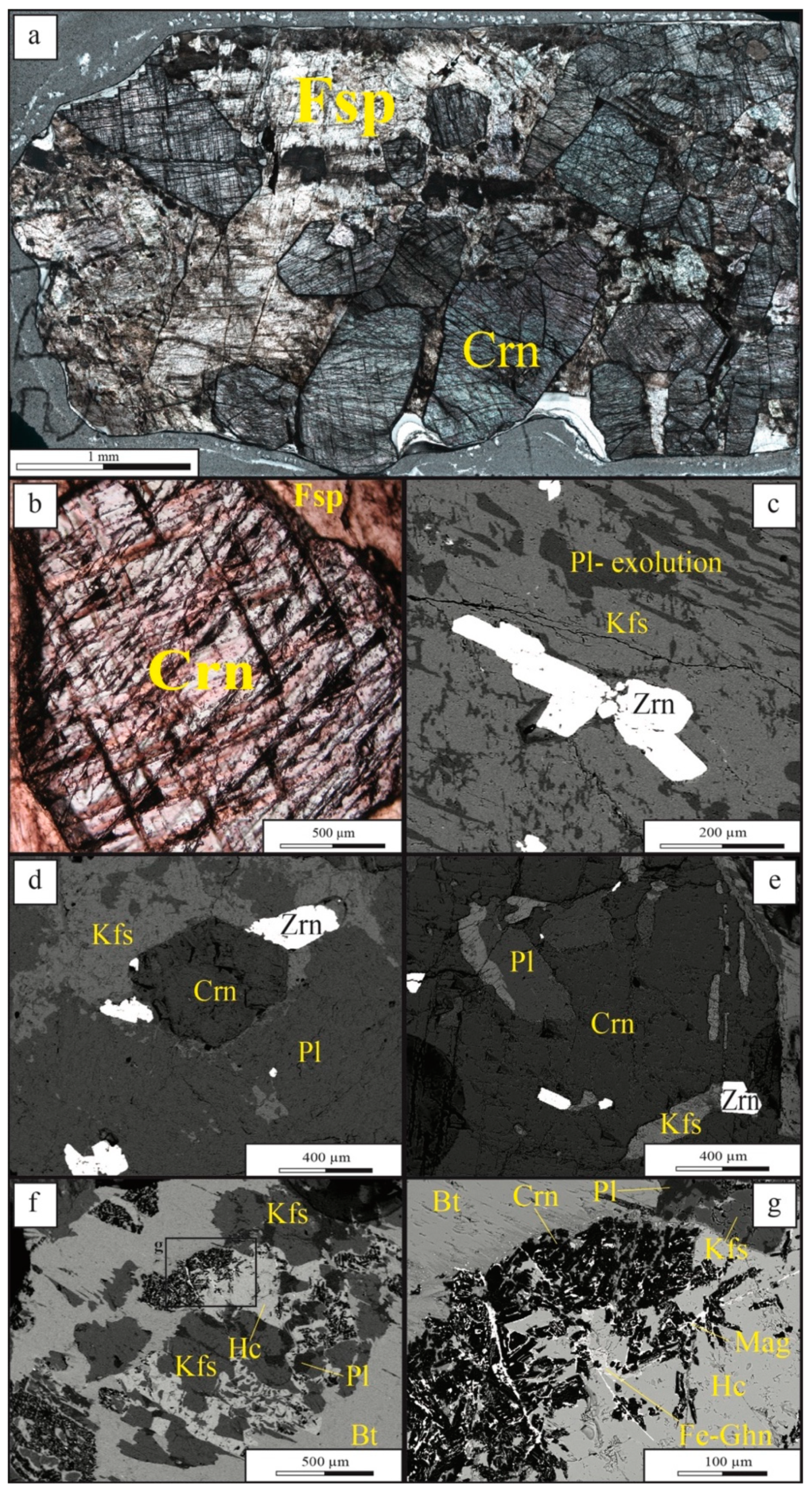
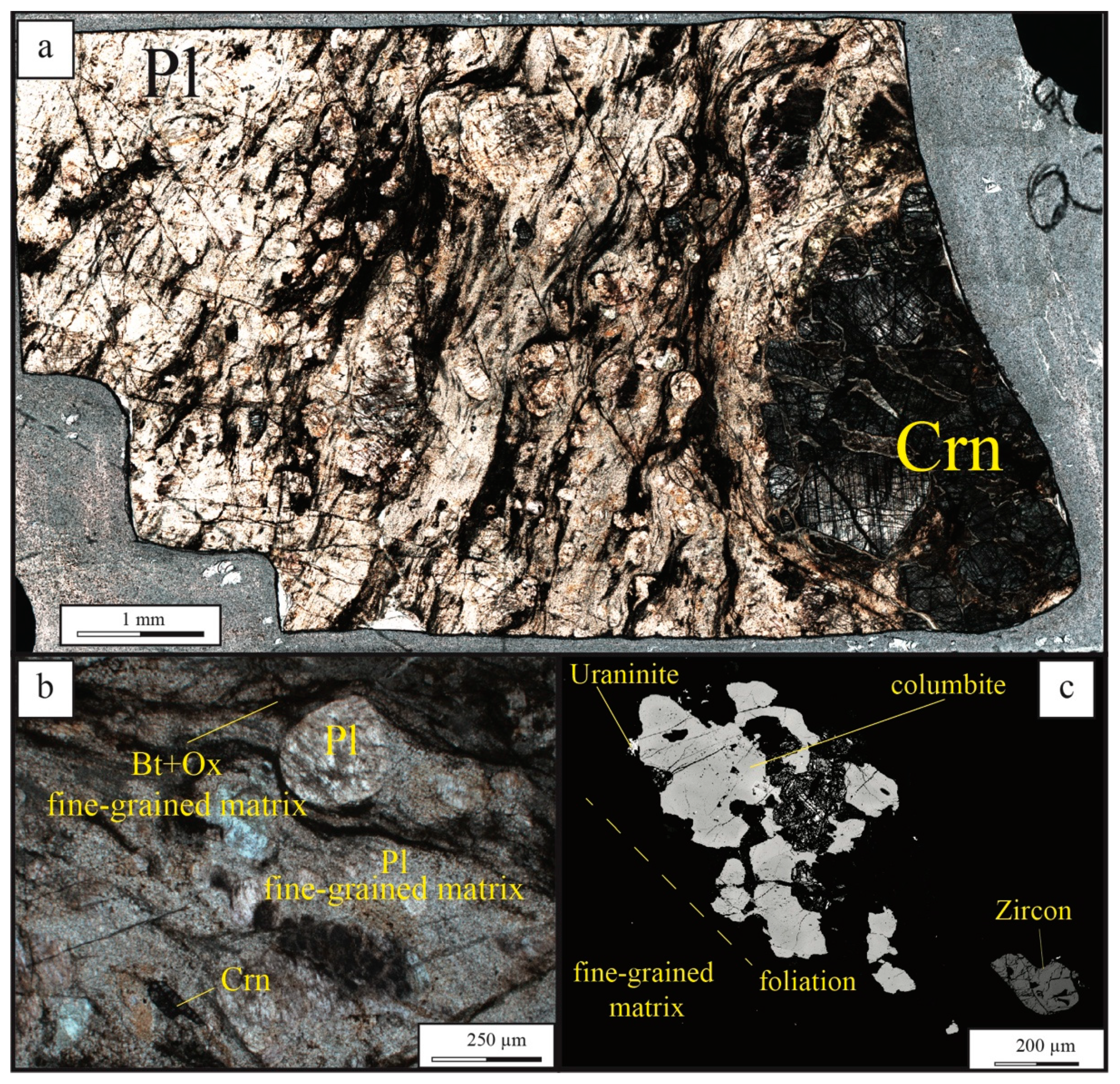

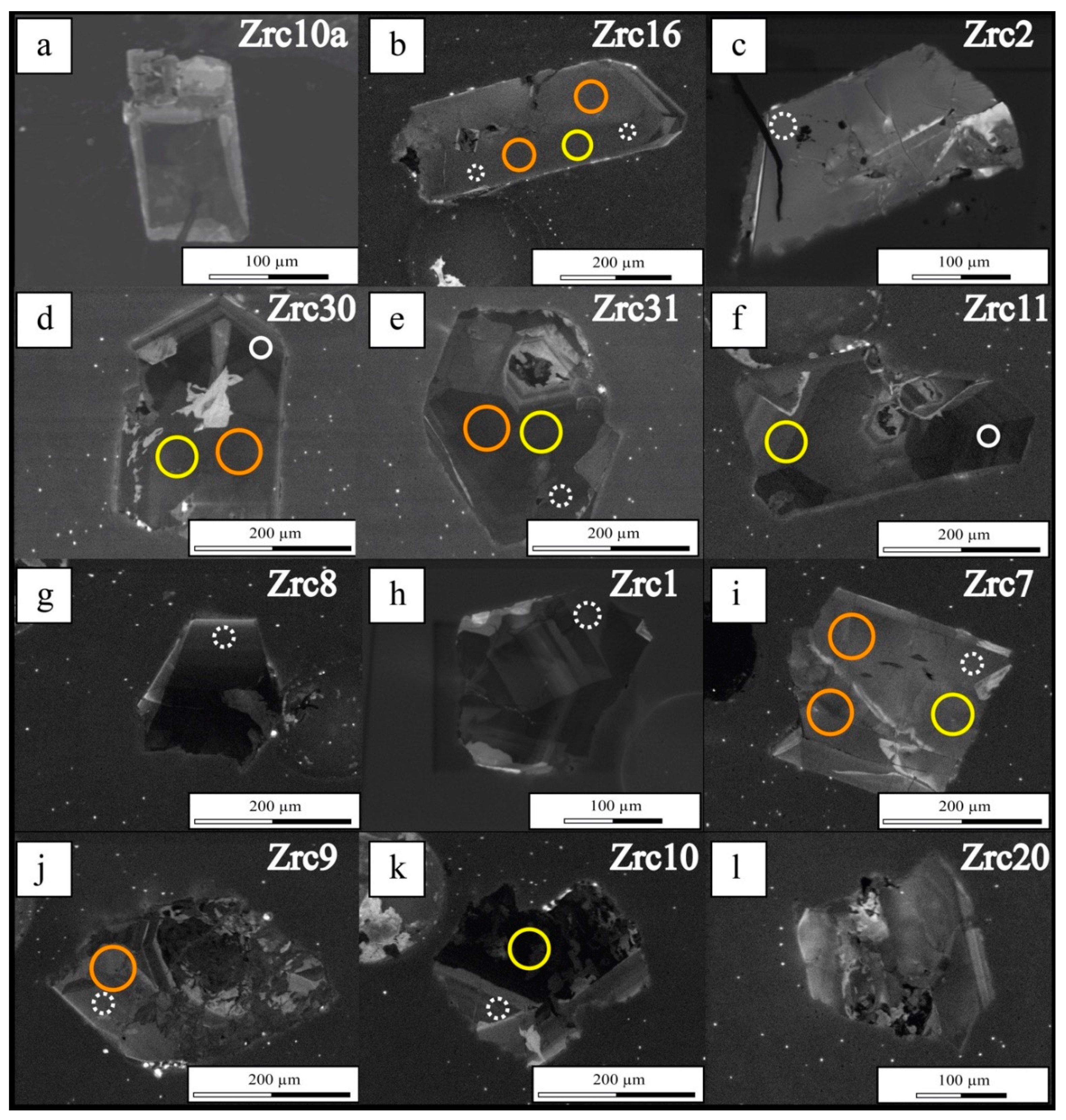
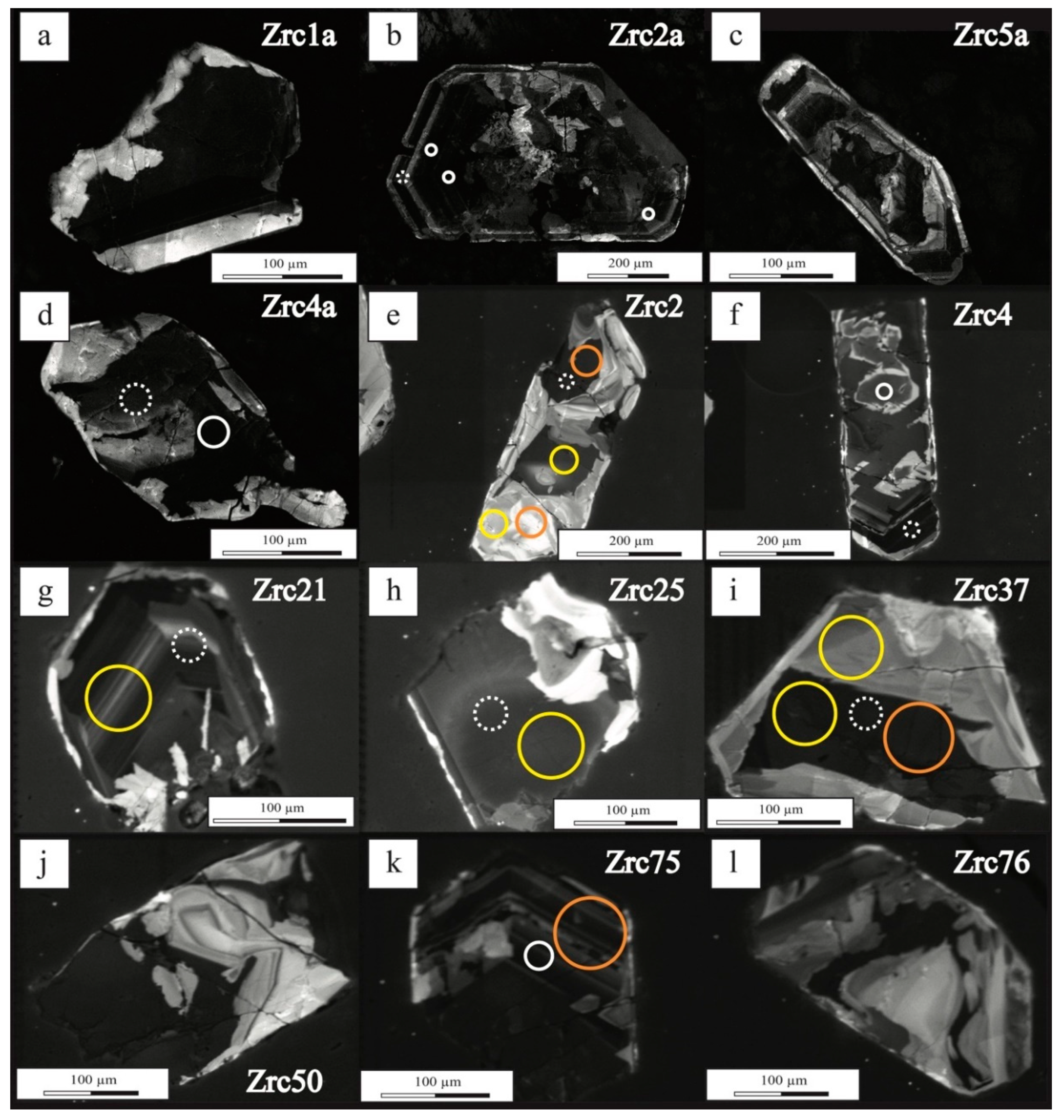
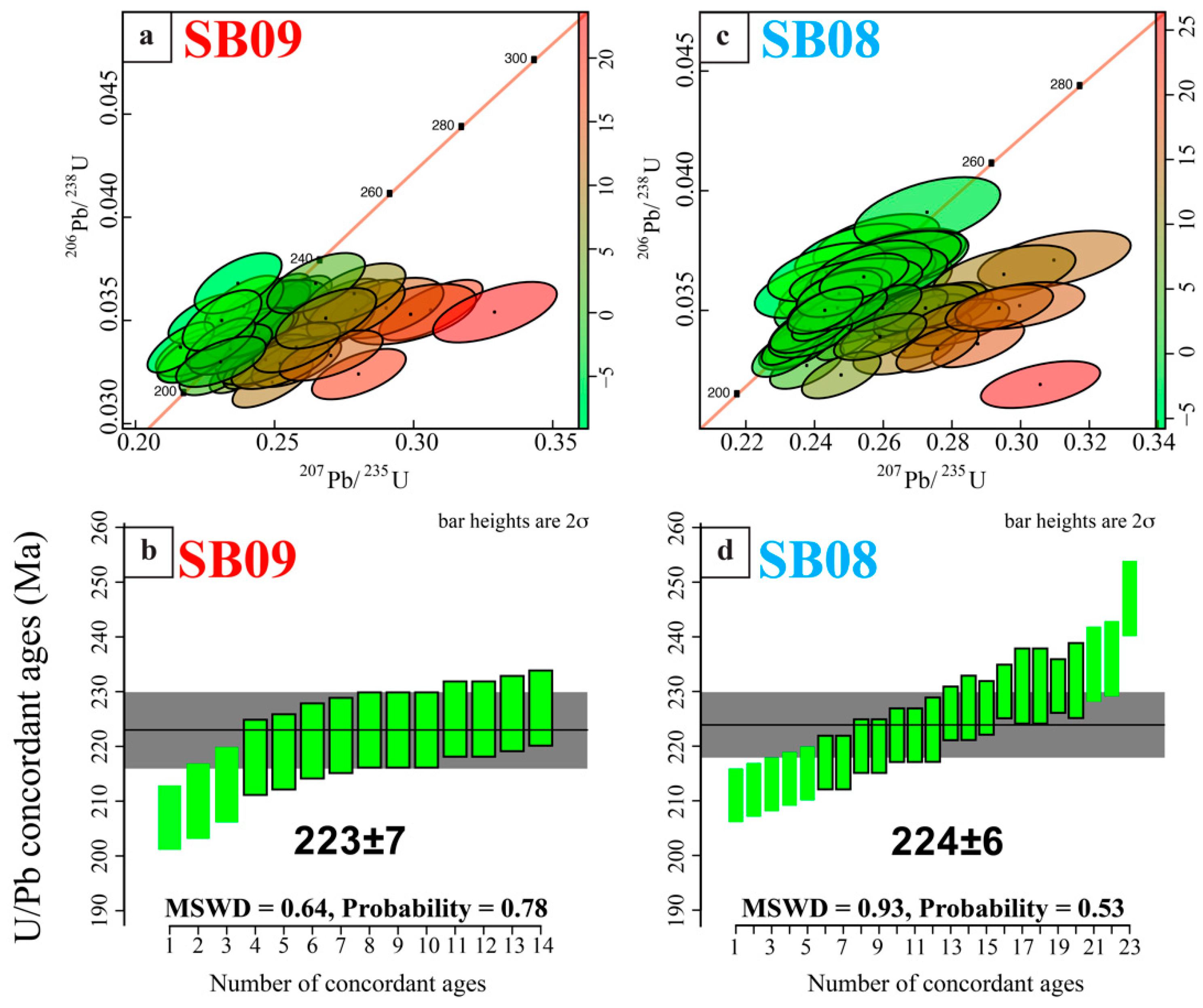
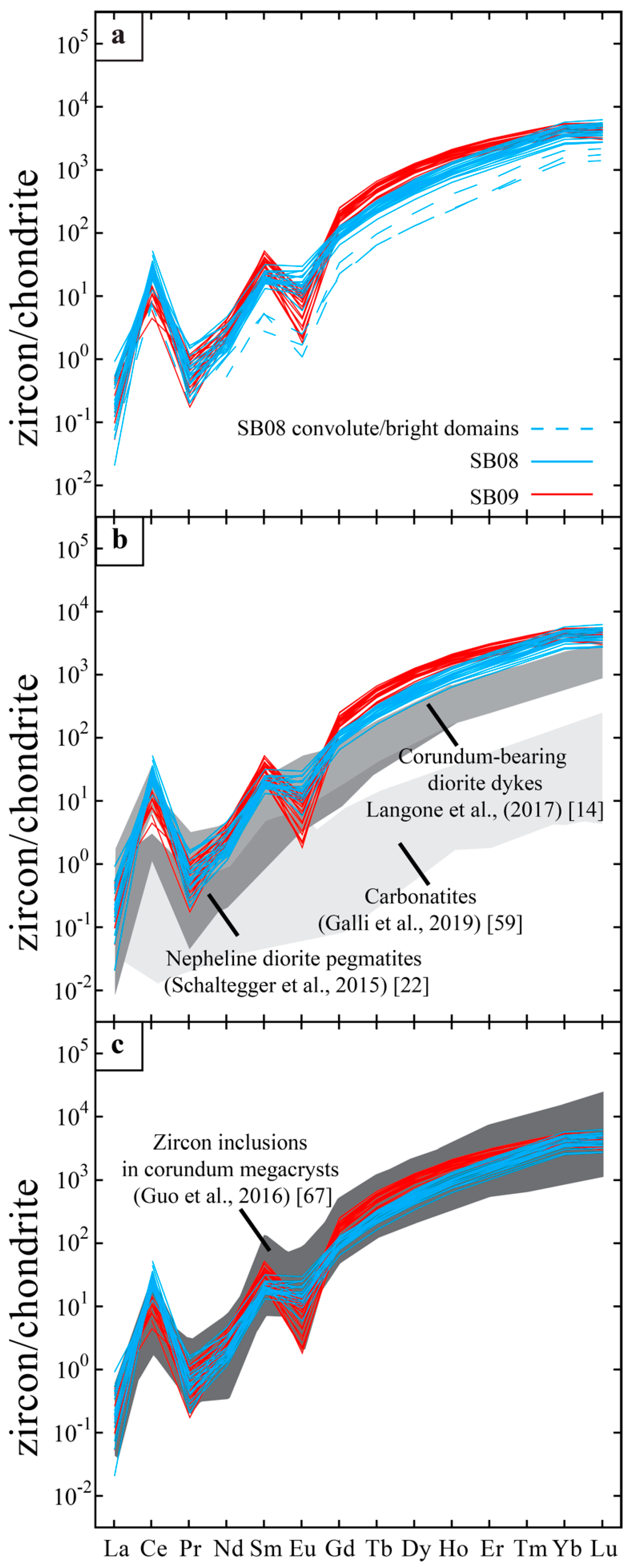
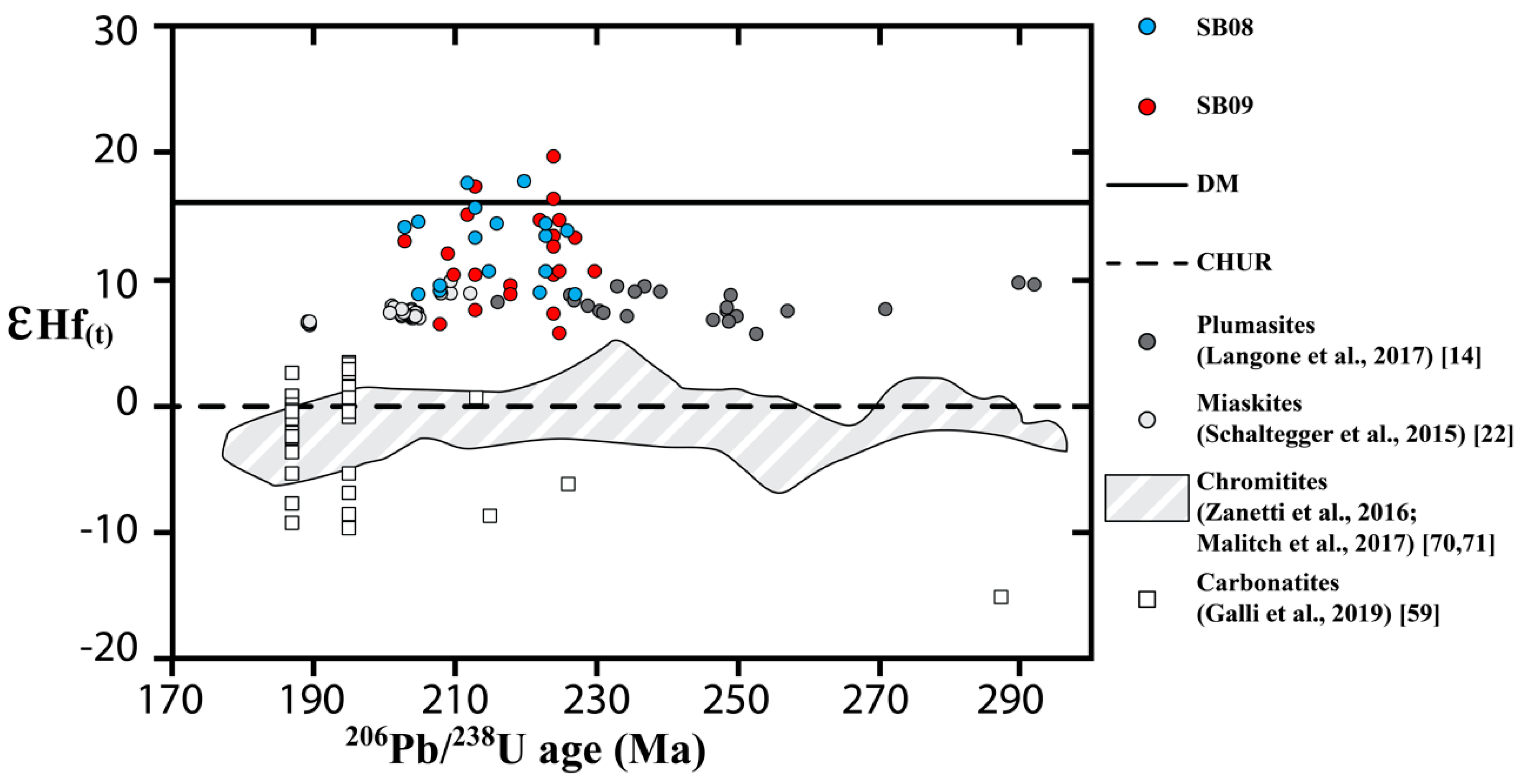
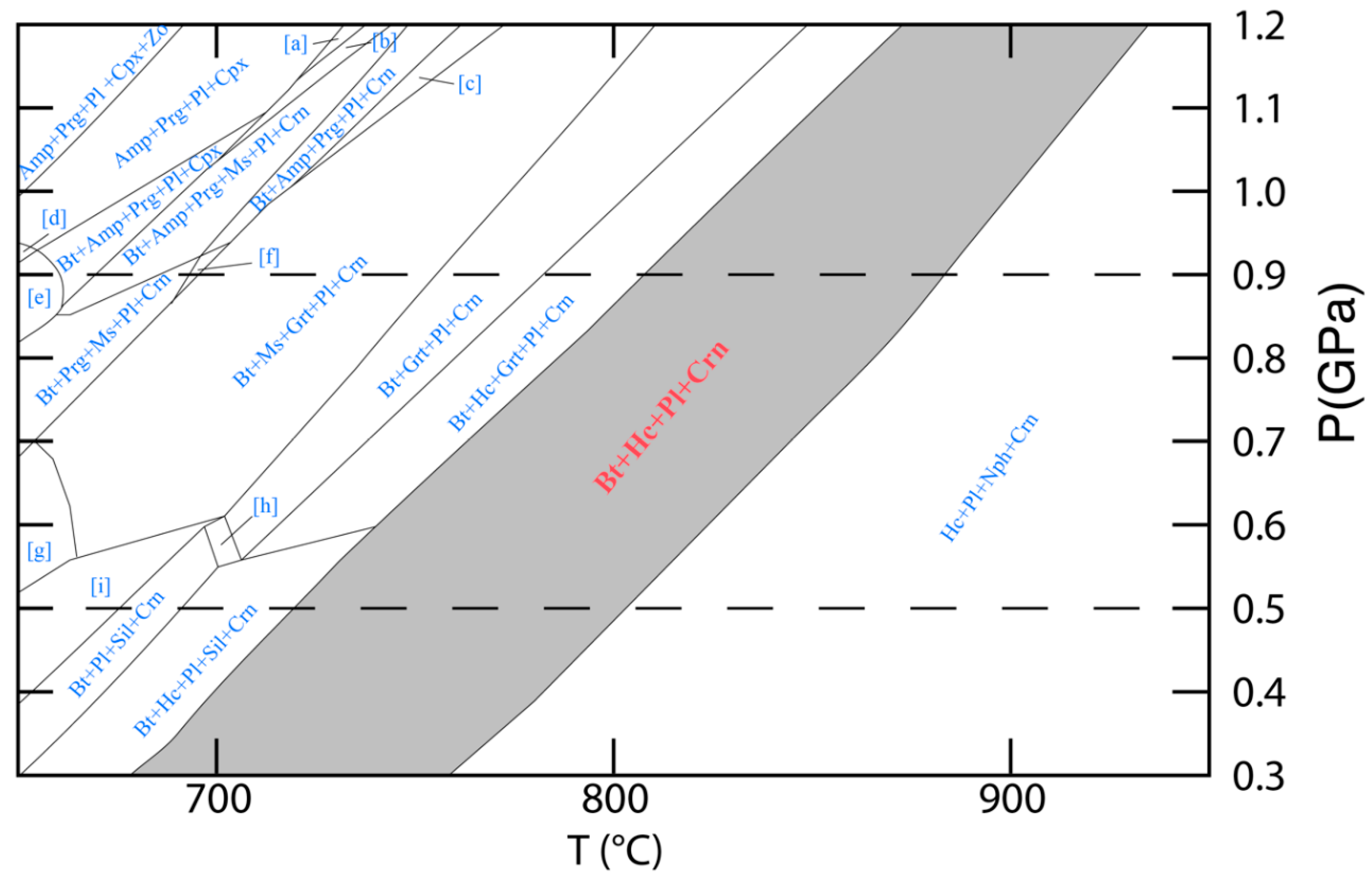
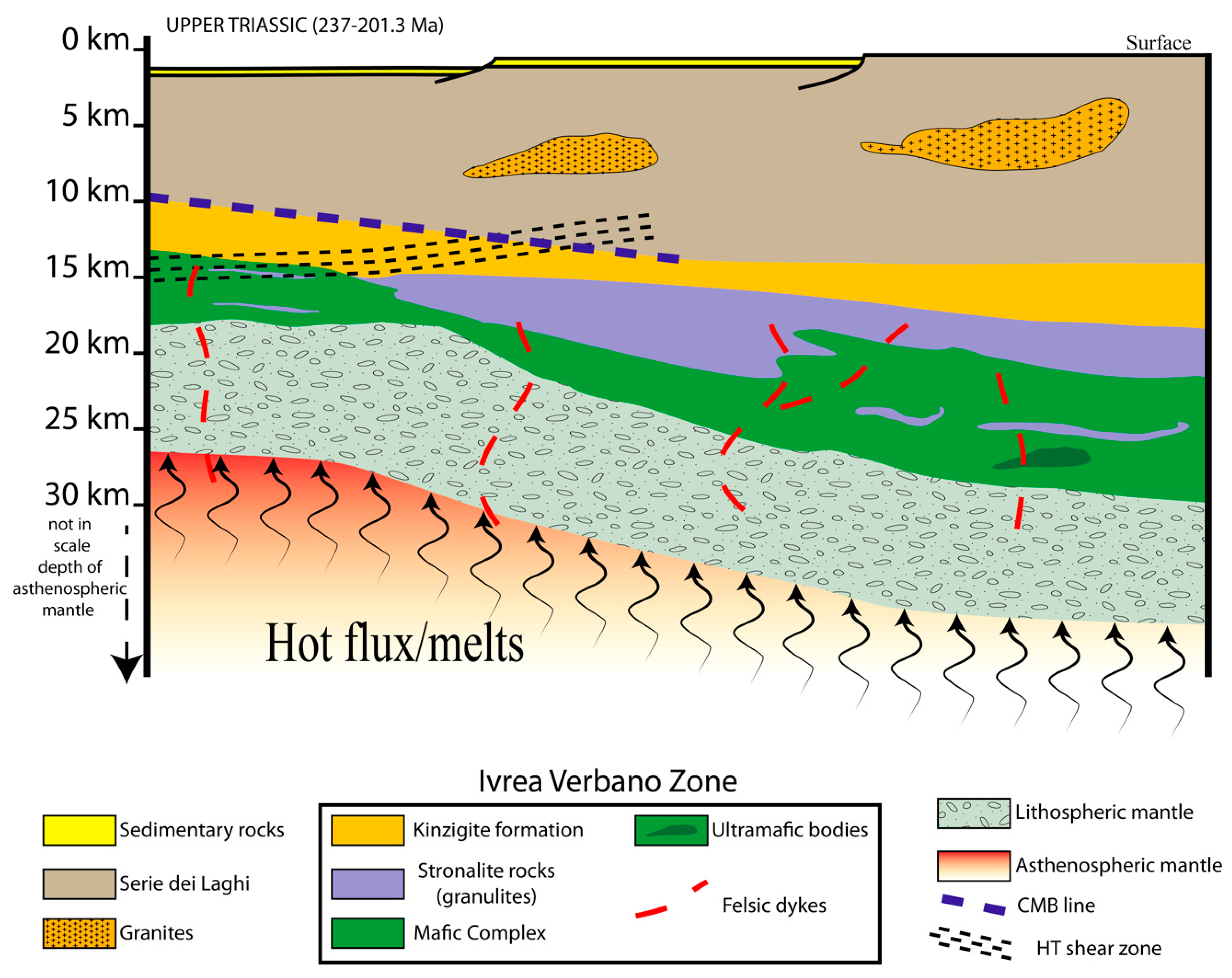

© 2020 by the authors. Licensee MDPI, Basel, Switzerland. This article is an open access article distributed under the terms and conditions of the Creative Commons Attribution (CC BY) license (http://creativecommons.org/licenses/by/4.0/).
Share and Cite
Bonazzi, M.; Langone, A.; Tumiati, S.; Dellarole, E.; Mazzucchelli, M.; Giovanardi, T.; Zanetti, A. Mantle-Derived Corundum-Bearing Felsic Dykes May Survive Only within the Lower (Refractory/Inert) Crust: Evidence from Zircon Geochemistry and Geochronology (Ivrea–Verbano Zone, Southern Alps, Italy). Geosciences 2020, 10, 281. https://doi.org/10.3390/geosciences10080281
Bonazzi M, Langone A, Tumiati S, Dellarole E, Mazzucchelli M, Giovanardi T, Zanetti A. Mantle-Derived Corundum-Bearing Felsic Dykes May Survive Only within the Lower (Refractory/Inert) Crust: Evidence from Zircon Geochemistry and Geochronology (Ivrea–Verbano Zone, Southern Alps, Italy). Geosciences. 2020; 10(8):281. https://doi.org/10.3390/geosciences10080281
Chicago/Turabian StyleBonazzi, Mattia, Antonio Langone, Simone Tumiati, Edoardo Dellarole, Maurizio Mazzucchelli, Tommaso Giovanardi, and Alberto Zanetti. 2020. "Mantle-Derived Corundum-Bearing Felsic Dykes May Survive Only within the Lower (Refractory/Inert) Crust: Evidence from Zircon Geochemistry and Geochronology (Ivrea–Verbano Zone, Southern Alps, Italy)" Geosciences 10, no. 8: 281. https://doi.org/10.3390/geosciences10080281




